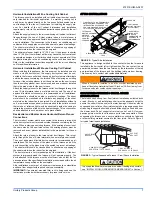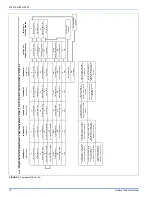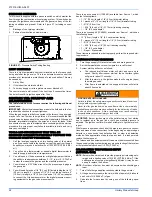
272312-UIM-A-0407
Unitary Products Group
17
VENTING INTO AN EXISTING CHIMNEY
For Category I installations, the furnace shall be connected to a factory
built chimney or vent complying with a recognized standard, or a
masonry or concrete chimney lined with a material acceptable to the
authority having jurisdiction. Venting into an unlined masonry chimney
or concrete chimney is prohibited.
Whenever possible, B-1 metal pipe should be used for venting. Where
use of an existing chimney is unavoidable, the following rules must be
followed:
1.
The masonry chimney must be built and installed in accordance
with nationally recognized building codes or standards and must
be lined with approved fire clay tile flue liners or other approved
liner material that will resist corrosion, softening, or cracking from
flue gases.
THIS FURNACE IS NOT TO BE VENTED INTO AN
UNLINED MASONRY CHIMNEY.
2.
This furnace must be vented into a fire clay tile lined masonry
chimney only if a source of dilution air is provided, such as by com-
mon venting with a draft hood equipped water heater. If no source
of dilution air is available, Type B vent must be used, or masonry
chimney vent kit 1CK0603 or 1CK0604 must be used. Refer to the
instructions with the kit to properly apply these masonry chimney
kits.
3.
The chimney must extend at least three (3) ft (0.91 cm) above the
highest point where it passes through a roof of a building and at
least two (2) feet higher than any portion of the building with a hor-
izontal distance of ten (10) feet.
4.
The chimney must extend at least five (5) ft (1.5 cm) above the
highest equipment draft hood or flue collar.
HORIZONTAL SIDEWALL VENTING
For applications where vertical venting is not possible, the only
approved method of horizontal venting is the use of an auxiliary power
vent. Approved power venters are Fields Controls Model SWG-4Y or
the appropriate Tjernlund GPAK model. Follow all application and
installation details provided by the manufacturer of the power vent. This
unit may be horizontally vented using 4” (10.2 cm) diameter pipe with a
minimum length of 4.5 feet (1.37 m) and a maximum length of 34.5 feet
(10.82 m) with up to 4 elbows.
VENT CLEARANCES
IMPORTANT:
The vent must be installed with the following minimum
clearances as shown in Figure 20, and must comply with local codes
and requirements.
FIGURE 18:
Typical Sidewall Vent Application
FIGURE 19:
Typical Sidewall Vent and Termination Configuration
FAN ASSISTED FURNACE
& WATER HEATER
FAN ASSISTED
FURNACES
VENT
PIPE
HOT
WATER
TANK
OPTIONAL
SIDEWALL
VENT SYSTEM
(field supplied)
EXTERIOR
VENT HOOD
FURNACE
FURNACE
VENT PIPE
FLUE
PIPE
BURNER
ACCESS
PANEL
CELLAR
WALL
OPTIONAL
SIDEWALL
VENT SYSTEM
(field supplied)
TOP
COVER
BAROMETRIC
DAMPER
















































